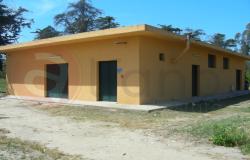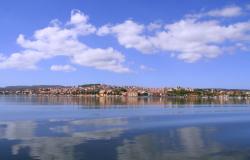In the arid countryside around Calangianus, Sardinia, bark is rudely stripped from the lower trunks of the gnarled trees that blanket the hillsides. Driving through this area—covered by parched earth, the occasional olive tree, and thousands of cork trees stripped of their bark—feels like traveling across the landscape of another planet.
“Cork is an ancient material used for everything from trays to stools,” Davide Sessa tells me, working from his small leather and cork studio outside of Cagliari. “My challenge is to make objects that no one has ever imagined could be made with cork.” Sessa’s workshop, filled with jackets, umbrellas, hats, shoes, and other items—all crafted from the bark of the island’s cork trees—stretch the imagination of what could be made from sughero, one of Sardinia’s most versatile raw materials.
 [Sardinian cork courtesy Davide Sessa]
[Sardinian cork courtesy Davide Sessa]
ANCIENT ORIGINS
The stripping of cork oaks (Quercus suber) is nothing new. In fact, we know that the inhabitants of pre-Roman Italy were already using cork to cap bottles of wine and oil, but they also used the material to make surprising objects. Pliny the Elder, the esteemed Roman naturalist, wrote in his Natural History that cork oaks were used “chiefly for ships’ anchor drag ropes and fishermen’s drag-nets, for the bungs of casks, and also to make soles for women’s winter shoes.”
Just as in centuries past, the processing of cork still begins with stripping bark from the oak, a process that does not harm the tree itself. The bark is seasoned in vast outdoor vats for up to two years. Then the cork is boiled and disinfected, dried, cut, and packaged.
 [Close-up of a cork oak tree in Italy, cork oak or quercus suber in Sardinia]
[Close-up of a cork oak tree in Italy, cork oak or quercus suber in Sardinia]
Although workers on Sardinia were well experienced with harvesting the bark of cork oaks and working the material for a variety of uses, it wasn’t until relatively recent times that they began exploiting the island’s natural resource on a wide scale. In the mid-nineteenth century, Sardinian entrepreneurs began to cultivate crops of cork oaks more systematically. They began to produce wine stoppers on a large scale, using their own local raw materials as well as bark imported from Corsica and mainland Tuscany.
Today, cork is considered one of Sardinia’s most characteristic natural resources and manufactured products. The town Calangianus, on the north end of Sardinia, is the island’s major cork production area. Hundreds of cork enterprises (sugherifici), large and small, are concentrated around this town of just four thousand inhabitants. The cork industry is divided into two main sectors, industrial and artisanal.
A POP OF CREATIVITY
Most of the industrial-scale cork factories on Sardinia are focused on the production of wine and champagne corks, or tappi,churned out in breathtaking numbers. A single sugherificiocan produce tens of thousands of tappiper day, many destined for the great wine producers of Tuscany and Piemonte. Sardinia has earned a worldwide reputation in the production of wine corks, because of the high quality of both the material and the long experience of Sardinian cork makers. Winemakers from Tuscany to California to South Africa—and most recently, China—import Sardinian wine corks in vast numbers.
Giovanni Pasella, a fourth-generation wine cork artisan, tells me, “Today, most of the production of tappi is consolidated in a few companies of enormous size. As a result, some of our smaller companies have decided to focus on specific, high-value steps of the processing. Others have pursued the production of “natural” corks aimed at the highest end of the market—intended for fine wines and special aging.”
 [Sardinian cork courtesy Artigianato Pasella]
[Sardinian cork courtesy Artigianato Pasella]
In the 1990s, there was a move among winemakers away from natural wine corks and toward plastic, but cork is coming back into vogue. “Cork is an exceptionally pliable material,” says Pasella. “European winemakers are returning to natural cork after a ‘parenthesis’ of the plastic cap.”
In addition, the larger cork factories are looking for new opportunities for the use of cork, and Sardinian entrepreneurs are exploring the use of cork in surprising ways—the production of shoes, of apparel, even eco-friendly building materials like wallpaper.
Pasella says that he believes Sardinia’s cork producers must continue to think beyond the wine bottle with their products and processes if they are to adapt to changing global markets. “We face many challenges, but those of us in the cork industry around Calangianus have always been good at collaborating to overcome obstacles. That takes determination—and humility.”
 [Sardinian cork courtesy Artigianato Pasella]
[Sardinian cork courtesy Artigianato Pasella]
SARDINIA HANDMADE
Quietly, alongside the larger cork producers, a handful of individual Sardinian cork artisans ply their trade. In fact, artisans on Sardinia will stretch your imagination for what can be made with cork. Before your eyes, they carve the material into frames, boxes, and even tea sets and jars.
Although tourism on Sardinia is on a much smaller scale than mainland Italy, it remains one of the most important sectors of the island’s economy. And, Pasella says, a growing number of those visitors are interested in their products. “We recognize that outside visitors to the island are an important driving force for economic growth,” says Pasella. “More and more people want to learn about cork processing. For us, it indicates how important it is to preserve our know-how and to share it with the growing numbers of visitors who come to Sardinia.”
Davide Sessa says that it’s not only a growing number of visitors to the island but also the creative impulse itself, that he believes will keep the working of cork alive for the next generation, whether in the making of wine corks or objects yet unknown. “What motivates me to create is often the desire to materialize something I’ve seen in a dream or vision. I don’t think about reselling a new creation. I make it for the pure joy of seeing something new born from my own hands. That’s the secret.”
WHERE TO EXPERIENCE SARDINIAN CORK
A lot of the cork wares sold throughout the retail shops of Sardinia are aimed for the tourist trade, stamped with scenes of Sardinia or silly sayings in Italian. Make the trek to Calangianus, or seek out the island’s individual cork artisans, to ensure that you buy a high-quality, handmade item directly from the source. Handmade cork items are relatively affordable, easily portable, and make great gifts to bring home in your suitcase.
 [Clutch made out of cork - from our Italy Magazine shop]
[Clutch made out of cork - from our Italy Magazine shop]
MUSEUMS
Museo del Sughero (via San Francesco 3, 07023 Calangianus, 346/3693859)
An old monastery in the center of town has been transformed into a wonderful museum dedicated to the art and history of cork-making around Calangianus.
Museo storico delle machine del sughero (via Limbara 9, 07029 Tempio Pausania, 079/672269)
Beyond Calangianus, in the town of Tempio Pausania, lies a small museum dedicated to antique machinery used to process cork. Call ahead to make sure you visit during their limited opening hours. A great place to take the kids!
ARTISANS
Anna Grindi Atelier (Tempio Pausania)
Anna Grindi, deemed the “queen of cork,” makes beautiful dresses, bags, and shoes out of the cork of her native Sardinia. Grindi has been a pioneer in cork innovation for more than two decades. Her clothes are only distributed for sale in chic boutiques across Europe, including the chain of stores she founded, called Suberis.
Artigianato Pasella (Località Ignazioni, Calangianus 079/661381)
Located among the industrial producers of wine corks on the outskirts of Calangianus, this fourth-generation artisan enterprise makes surprising objects from cork, along with creative ceramic wares. Although they distribute to stores across Sardinia, it’s worth the visit to this workshop to watch the artisans make your souvenirs on site.
Davide Sessa Artigiano Pellettiere (Corso Vittorio Emanuele 19, 09010 Pula, 070/9249013)
Davide Sessa’s leather and cork workshop, located just beyond Sardinia’s capital city of Cagliari, will amaze and delight you when you realize what can be made with the island’s most versatile material.
I.S.O.L.A. Artigianato di Sardegna (via Bacaredda 176-178, 09127 Cagliari, 070/492756)
This is the last-remaining retail outlet of a once-thriving government initiative to promote authentic craft traditions of Sardinia. Shop here not only for items made of cork, but also to support the island’s makers of authentic textiles, ceramics, jewelry, and more.







